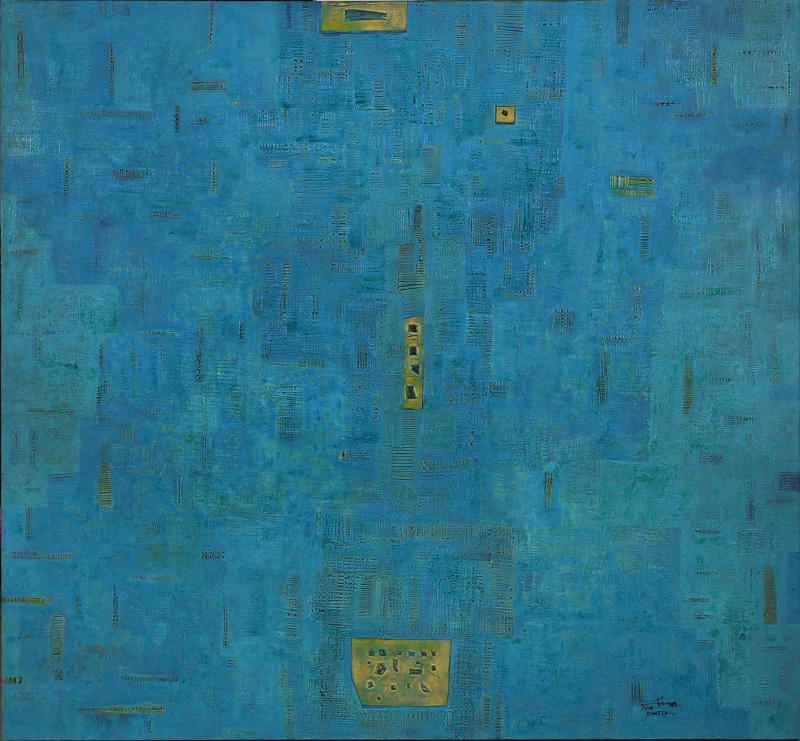Much has been said about a ‘narcissistic wound’ in our contemporary identity, but Narcissus always remains sick with his love of himself. He does not see the one who loves him. He does not see Echo, the goddess of mythology who loved him. Rather, he was in love with himself, just like a ghost imprisoned in a mirror. We must then think of a wound of another kind- an ‘aesthetic’ or a configurative one, or possibly a wound in the mirror itself in a way that Narcissus is rendered a face in which he can see himself only through his wounds, and he has to love them as he has no other face to see himself.
But how can we think of an aesthetic wound?
Paul Ricoeur proposes the concept of the ‘wounded cogito’ (cogito blessé). It stands for an ‘I’ that thinks of itself only to the extent that it loses it. Ricoeur said, “The wounded cogito presents itself but does not possess it.”(1) What is the wounded cogito? It is an ‘I’ that realized late, and with chagrin, that ‘I think’ does not always fit ‘I am.’ Rather, perhaps ‘I am’ can be what I am not thinking about or what I am not aware of. There is, then, a dark space in all our self-awareness into which ‘thinking’ cannot shed its own light. However, we continue ‘being’ with all our heart. According to Ricoeur, Freud may help us to re-read Descartes as a philosopher who claimed to construct a ‘cogito’ capable of possessing all the space of ‘consciousness’ merely by thinking. However, the result is the construction of “the imaginary cogito that firstly occupies an establishing position,” and thus the only suitable task left for philosophy is to “debunk the false cogito” through what Merleau-Ponty called “the archeology of the self.”(2)
The wounded cogito is an ‘I’ that meets itself only through means it has no control over. He who wants to know himself must postpone it until he seizes the appropriate wound. In other words, he should not covet direct awareness of himself as there is no direct certainty of ourselves but multiple and fragile attempts ranging from impossible transparency (I = I) to an impossible hegemony (an ‘I’ without the other). “Speech is never transparent to itself.”(3)
The challenge is as follows: How can ‘I’ be myself knowing that there is no such a doubtless ‘cogito’ as the Descartes-claimed one. Descartes is then an impossible philosopher or cogito. The seriousness of this description is intensified to the extent that modernism seems to be a hostage to this revolution in human ‘consciousness’ in the sense that modernism is a new policy of our awareness of ourselves. However, this awareness entered into a crisis as soon as we started asking it questions that it cannot see because they relate to the dark side of the moon. The “crisis of the concept of consciousness”(4) is not a personal problem, but it is an internal feature of modern man’s relationship with himself. Ricoeur assumes that the crisis of consciousness is not an accidental event, but it has been ever since; this is what Descartes deliberately concealed from us. Descartes decided, on our behalf, on something that is not possible: ‘I think, therefore I am’ or ‘I exist.’ That was a perilous claim that concealed from us that the identification between thinking and being is only a good assumption, but it is unreal. Awareness of ourselves is a task that we need to accomplish, not something that we need to find. Therefore, Ricoeur said, “Consciousness is that which cannot collect itself.”(5) We are us only in the end- when we succeed in shaping ourselves. Who is then Descartes for us?
“His philosophy testifies that cogito’s crisis was concurrent with its assertion.”(6)
Who accepts this original challenge needs to figure out how to cut through the thorny and complex path from the impossible ‘I’ to the possible ‘identity.’ This means that all of us can only meet ourselves in the third person- in the sense of ‘identity.’ There is no immediate ‘self’ that we can claim irreversibly. Each of us can be referred to as ‘he.’ Perhaps this can explain why our (Arab) grammarians preferred the abstract third-pronoun form to control the significance of any verb in which a verb does not convey its full significance except in the ‘past’ form. Then the meaning of ‘identity’ applies to it; that is, ‘he’ implies ‘he was himself.’ However, no one exists in the past, and the past no longer sees us. As such, any ‘I’ refers to ‘himself’ only through fragile lenses that need to be ‘changed’ every time. ‘He’ has to be ‘reflected’ on a screen to appear to himself. The light that shows us is outside ourselves. Hence, we always need a ‘turn’ to meet ourselves. Transparency is a mirror-claim that immediately throws the ‘I’ into an abandoned land where there is no one, but who can bear that he is ‘no one?’ Even the toughest kinds of loneliness are inhabited, at least by the absent ones- those from whom we draw our own genealogy as ‘others.’ There is no impassable path to the ‘I;’ rather, there are good crossings and mediators. In other words, we point at ‘others’ who are well-trained to meet us and shape us in the horizon of themselves.
The ‘I’ is not a ‘thing,’ so it does not claim to be ‘the same’ every time except in terms of promising. There is no core nucleus for anyone to be repeated endlessly; nevertheless, it is only about a special ability to shape ‘itself’ freely. I promise to be myself every time, but this promise is nothing. It will never be ‘the same’ forever, and every ‘I’ will have to change its words about itself until the end. Put differently, it will have to put up with its ‘otherness’ in terms of belonging to it, and not as a disposable part of its existence. Each ‘other’ is a loss if we conceive it as a thing; that is, an identity ready and absolutely identical to itself. That means without us.
As such, a ‘wound’ does not imply an external offense, but it is an imprint on the body of each of us. Every ‘I’ is a previous ‘here;’ that is, a form of a ‘place’ that, thanks to our fragility, has become a ‘being’ that we have to nurture. You can be yourself only in terms of your relationship with a place, and it is the ‘I’ that transfers ‘place’ from the world of things to the world of ‘being.’ Are you in the place of yourself every time? Who wounds the place?
Ricoeur’s strength utterly emanates from considering that “The battle of the cogito is over.”(7) The ‘I think’ has no longer anything to conquer, just as if the ‘modern’ consciousness withdrew from the horizon of the contemporary European individual. Nevertheless, that is only a part of the problem that haunts the philosopher; no one can remain without an ‘I.’ Moreover, we have to distinguish between the end of the battle of ‘I’ and the existence of an ‘I.’ ‘I’ is indomitably forced to resume its relationship with itself no matter how ‘wounded’ it is by others. Thus, instead of constructing a ‘philosophy of cogito’ in the fashion of modernists from Descartes to Husserl, Ricoeur proposes a modest thought a fierce task; we have to practice ‘self-hermeneutics.’ That is, we have to exercise hermeneutics on ourselves while we are “On an equal distance from defending (and praising) the cogito and attacking (and overthrowing) it.”(8) We have to treat the cogito like a (philosophical) ‘father’ who is fatigued from the missing certainty in which it is not clear whether there is “not enough of him or there is too much of him.”(9)
According to Ricoeur, the weakness of the cogito claimed by Descartes is the greed for a ‘final establishment’ of self. The Descartes-claimed cogito wanted to create a certainty greater than its nature, and every ‘I’ that does this suffers from a ‘foundational ambition-’ the disease of the ‘first truth.’ No one can be his first truth. We exist, but we do not establish our existence. What each ‘I’ forgets is that it inhabits a special body, and it must treat itself as a soul ‘uprooted from all signs of time and space.’ Descartes ‘doubted,’ but he hid his ‘despair’ from us. He made us believe that the “Cartesian doubt is not the Kierkegaardian despair.”(10) The philosophical solution was to invent an identity without adjectives- an identity that says ‘I think’ and defines itself accordingly but does not know another meaning that makes it ‘who it is.’ What Descartes did was to deprive the ‘I’ from asking “Who?”(11) and to throw it into an empty shell called ‘cogito’/ ‘I think’ without any ‘other’ content, other, body, place, …etc. “At this point, the ‘I’ completely loses any specific designation as it becomes a thought- an understanding (mind),” but why can’t thinking be an identity? Thinking strips the ‘I’ of its ‘narrative identity,’ deprives it of claiming that it is a ‘specific and concrete person,’ and turns it into an ‘ahistorical’ identity- an “instant cogito”(12) that can be released whenever we want, just as a dumb ‘he himself.’
Ricoeur suggests the ‘I’ to be returned to the ‘narration character’ that hides behind its sayings. Only then is the ‘I’ not an ‘uprooted self’ as conceived by Descartes. We are only a ‘self-version’ of ourselves, but we will never know it unless we acknowledge the ‘fragile certainty’ we have about it. We have to acknowledge that “When I, the cogito, am left to myself, I become like Sisyphus, who is condemned to carry the rock of his certainty and ascend with it every moment, contrary to the decline of doubt.”(13)
He who thinks in this way screens Sisyphus who stands behind his mask. Descartes invented a type of self whose raison d’être is based on discarding “any psychological hue or reference to autobiography.”(14) He who thinks can only metaphorically say ‘I.’ He has to give up the ‘interlocutor’ to make way for a sans-identity ‘I think’ which Kant claimed it “must accompany all my perceptions.” This ‘I’ has nothing to tell us about itself; it has stripped away its story for our sake. Ricoeur said, “The problem of the self emerges here, and, in a sense, it has grown enormously; nevertheless, this occurs in exchange for its loss of all connection with the person we are talking about.”(15)
Descartes believed that entering new times requires alleviating our ‘narrative identity, our current ‘version of self, or our ‘autobiography,’ which can make ‘I think’ a ‘person.’ Descartes’ cogito is, then, not an ‘identity of a historical person’ but a technique of ‘exaggerating’ the ‘I’ to take over the world without any need for a body to suffer for it. He said, “Is there anything deeper and stickier to the soul than pain? However, I learned in the past from some people whose arms and legs were amputated that it sometimes seemed to them that they felt pain in the amputated body parts, which made me think that I also could not make sure that there is real harm to one of my body parts even if I feel pain in that part” (The Sixth Meditation, par. 14).
The cogito was a deceitful philosophical feat. It is the site of a crime against one’s own body and not a comfortable concept. According to Descartes, he who thinks must begin to treat his own body as if it were an amputated organ and his pain as a hearsay.
Descartes believed that paying this ‘price’ was inevitable, but do we have any other choice? Ricour said, “Modernity owes to Descartes that, at least, he presented it with such a terrible choice.”(16)
What if there were another path to the horizon of modernism that Descartes did not see? In other words, it might be a path that does not pass through the self that thinks but rather through one’s own body that suffers- the path of the ‘wounded body.’ The body is not just an extended ‘body’ as Descartes cogitated or as physicists thought, but it is rather a space of emotions, a tactile space, an exceptional soil for the possibility of conceiving the meaning of being in the world. There is no ‘body’ without organs but rather a body of this or that person. One’s own body is a map of one’s biography, not a piece of nature that we find outside ourselves. The body does not think. Then we have to visit it where it is- in its mirror where it sees itself. But who can speak on the behalf of the body and tell how it sees itself? There is one concept that unites the body in its view of itself, and no other organ has this characteristic but the ‘face.’ Every ‘body’ is as special as it is a face that no one can claim. The face is the only mask for the body, but it is not a mask for anyone else. Perhaps this is what made Narcissus fall in love with himself, and he did not succeed in loving the woman (Echo) who sees him. Narcissus’ failure to see the face of another body made him a ‘wounded cogito-’ an ‘I’ without an ‘other.’ The ‘I’ thinks but sees nothing but itself. Descartes can be viewed as the bold execution of Narcissus sans face; that is, without body, and consequently, unable to love himself beforehand.
Now, if we look at the whole history of modernism as a history of the body in terms of a silent, not-voiced, and unthought-of history of a body that was early expelled by Descartes from the program of truth, we would be amazed at the magnitude of the meaning policy that prevented the modern body from inventing its own ‘cogito.’ The cogito of the body is still an unlikely promise. There is an impossible and unthoughtful cogito spreading in disguise or undercover in modern times as a satirical spectrum that ranges from Cartesian’s ‘stretched object,’ to Merleau-Ponty’s ‘body-flesh,’ and finally to the gender-body which transcends genders through Nietzsche’s ‘sick’ body as a body of the truth. However, it does not reach its inner limit except when it finds itself ‘wounded-’ when the body exits the ‘I can’ area to the ‘I am fragile,’ ‘I am damaged,’ or ‘I cannot’ area. According to Merleau-Ponty, we only discover this upon our surprise that the ‘other’ is ‘primarily another body-’ a body that is not me and a body that I will never be. Another area of ‘feelings’ or ‘pain’ that I have no right to bring home is the inability to be ‘owned.’
But how can a wound be an exceptional signature of one’s own body? Of course, the body has its organic and ancient signatures. It bore from the beginning its wounds which were healed and turned into organs. Nevertheless, the wound that can rebel against any ‘I think’ is the wound that enters its identity, in the ‘face’ of the soul that a body pretends in the mirror. It is the wound that sets foot in the identity of one’s own body and creates the hidden nexus between the ‘scene (skênê)’ where the bodies appear and the ‘body’ as a ‘tent (skénos)’ of the self, according to Plato’s metaphor. What the wound does is erecting one’s own body as a tent for the self.
Today, however, it seems that the best test for this wounded cogito is plastic medicine that works on the wounds of the human face. What does ‘wound esthetics’ do when a face is put back in place or to its self-mirror? Does this create an ‘aesthetic wound?’
The wound is a very distinct ‘configurative’ premise which imposes close negotiation and cooperation between medicine and aesthetics. We find ourselves in front of a unique event; ‘plastic surgery’ finds in here a wonderful turning point that calls for contemplation. It is no longer necessary for philosophy to search for the ‘whatness’ of ourselves in a faculty of thinking that lies ‘outside’ our bodies. We rather have to prove it via speech. What we call ‘ourselves’ is a configurative process in which our members play crucial roles. The self is what the body sees in the mirror- feeling that this is a ‘hand,’ this is a ‘face,’ this is ‘skin,’ … etc. It is my ‘tactile’ space that makes me come back to myself every time. Therefore, the wounds are not outside ourselves; they rather invite us to reshape the body as it saw itself for the first time. For this reason, a surgeon who restores a face, jaw, skull, hand, breast, burn, lip, … etc. is ‘forming’ a self and restoring an identity in its place. In other words, he is not just performing a technical physical action. A wounded body is also a wounded cogito and not just something sprawled out on a doctor’s table. Behind every wounded body is a wounded identity that we ought to repair. This means that identity is not an irreversibly given essence but rather a dynamic map of senses. The surgeon retrieves the original meaning of aesthetics- not a ‘theory of the beautiful’ (aesthetics) but the art of the ‘sensible’ (aisthêtikós). Perhaps philosophers were right when they did not find any other definition of ‘beauty’ else than ‘feeling’ it. However, because there is no sense without organs (without a body), metaphysicians were forced to expel ‘feeling’ from ‘beauty’ on the charge of belonging to the body- this ‘being’ of senses which is unreliable pertaining to the truth. Plastic surgery returns the ‘aesthetic’ to the ‘body’ and the beauty to the sensible as the only configurative wealth of our human identity.
Finally, what can ‘mind’ be in a culture when we have to think of a wounded cogito? Wittgenstein argues that thinking would then only be a ‘therapeutic’ exercise; we treat linguistic diseases and do not prove cold truths. Suddenly, one’s own body has become an unprecedented ‘wounded cogito’ that is ‘shattered’ by knowledge and struck by its ‘unconsciousness,’ and a body that does not own ‘itself’ and is infected with the truth, just like a narrative infection of the absent. Then, all of a sudden, philosophy becomes like a plastic surgery which restores the image of the self only as one’s own body can tell it. He who thinks mends his wounded mind with truth, and he who lives repairs his wounded body with identity.

1. Paul Ricoeur, The Struggle of Interpretations، p. 289, the Arab association for translating, Beirut2005.
2. Ibid.
3. Ibid. p. 296.
4. Ibid. p. 139.
5. Ibid. p.140
6. Paul Ricoeur, Oneself as Another (Beirut: The Arab Organization for Translation, 2005), p. 74.
7. Ibid. p. 73
8. Ibid. p. 73
9. Ibid. p. 74
10. Ibid. p. 75
11. Ibid. p. 77
12. Ibid. p. 78
13. Ibid. p. 81-82
14. Ibid. p. 84
15. Ibid.
16. Ibid.
Fathi Meskini was born in the city of Jendouba, Tunisia in 1961. He received his doctorate degree in philosophy in 2003. He authored numerous books which were highly lauded by his peers, including: ‘Hiegel and the end of metaphysics’ published in Tunisia 1997, ‘Identity and Time’ published in Beirut, 2001, ‘Critique of Hermeneutical Reason’ published in Beirut, 2005, ‘Identity and Freedom’ published in Beirut, 2011, ‘Thinking Post Heidegger’ published in Beirut, 2011.






